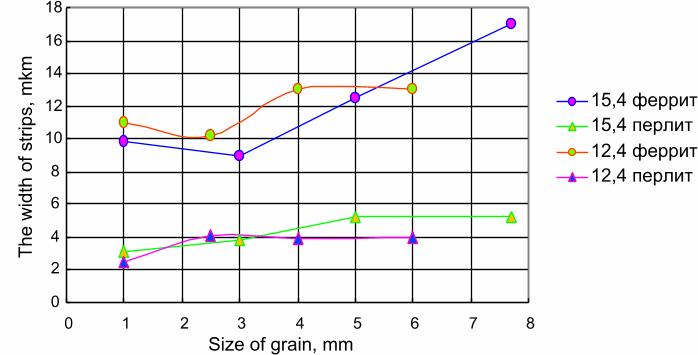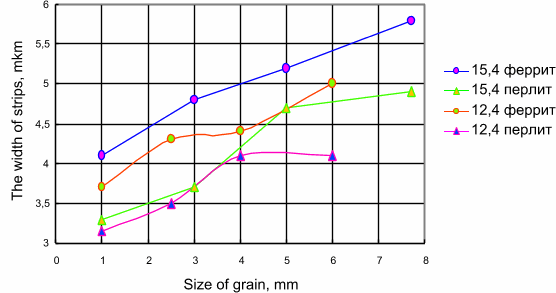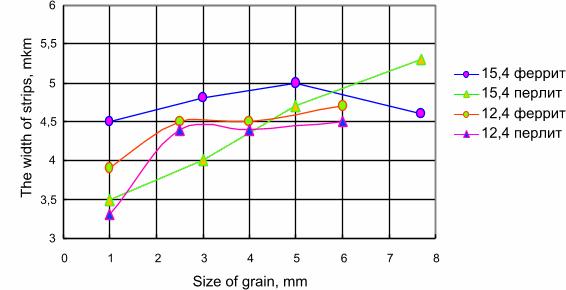Gorbatenko. V.P., Lukin A.V., Grinenko D.V.
Introduction
At the moment, for manufacture of pipes of the big diameter low-alloy, low-carbon steels which thanking a controlled rolling receive high level of mechanical properties are widely used. Along with it, hot rolling with the further normalisation or toughening widespread stays. In some cases heat treatment is way of correction of defects of structure and increase of an output of ready metal after controlled rolling. The purpose of the given work is studying of structure and properties of low-alloy pipe steel 13Ã1Ñ-Ó after controlled rolling and heat treatment.
Plates are object of research with thickness of 15,4 and 12,4 mm from a steel 13Ã1Ñ-Ó, made of OAO «ÌÊ Azovstal» on technology controlled rolling with ending of deformation at temperature 720-730 0Ñ. Chemistry of steel: 0,14 %Ñ; 1,62 % Mn; 0,50 % Si; 0,005 % S; 0,021 % P; 0,018 % Ti; 0,035 % Al; 0,005 % V, 0,01 % Nb; 0,010 % N2.
Results
On plates it was studied structure and properties in "head" of plate and in centrelengths of steel. Heat treatment was made at following modes: temperature of austenization 900-920 0Ñ; dwell time on all modes - 20 minutes; cooling at normalisation was spent on air, at full annealing - in furnace, at tempering - in water, heating temperature at relaxion annealing - 500 and 600 0Ñ (cooling with furnace); and at high air tempering after tempering - 550 and 620 0Ñ (cooling on air).
After controlled rolling became 13Ã1Ñ-Ó with ending of deformation at 720-730 0Ñ in plates with thickness of 15,4 mm strength is less, and plasticity is more (tabl. 1) than in plates with thickness of 12,4 mm whereas, indicators of impact toughness KCU and KCV have close values. Steel structure is ferrite-perlite with strongly pronounced foliation. Near to a plate surface structure orientation in a direction of a fleas of metal without clear strips is observed. On distance ~ 1mm from a surface it is already observed foliation of structures.
| Thickness of plate, mm | σuts, Í/ìì2 | σy.l, Í/ìì2 | δ2, % | KCV-20, Äæ/ñì2 | KCV-60, Äæ/ñì2 | KCU-60, Äæ/ñì2 |
| 15,4 | 604 | 510 | 40,0 | 142 | 111 | 148 |
| 12,4 | 622 | 514 | 35,5 | 141 | 109 | 148 |
At approach to a core zone the width of strips increases also they become practically continuous. In an core zone of plates with thickness of 15,4 mm liquating strip with thickness to 0,3 mm is observed. In plates with thickness of 12,4 mm distribution of a thickness of strips of ferrite more uniform, than in plates with thickness of 15,4 mm (fig. 1).


Fig. 1 - width of strips of ferrite and perlite in "head"(a), in the middle on length (b)of sheets of a different thickness.
The quantity of pearlite component in plates of a different thickness in a superficial zone is identical: 28 % in "head" and 32 % in the middle of length of the plate. The tendency of increase in a fraction of pearlite in structure from a surface to a core zone in plates of thickness 15,4 mm is shown. The size of grain of ferrite and segments of pearlite increases in a direction from a surface to a core zone (fig. 2).


Fig. 2 - the Average size of grain of ferrite and segments of pearlite in "head" (a) and in the middle of length of plate (b) steel 13Ã1Ñ-Ó.
In plates with thickness of 12,4 mm the average size of structural components is less, than in plates with thickness 15,4 mm. Hardness of steel with thickness 15,4 mm increases in a direction from core to a beforesurfase zone from 81-83 HRB till 84-87 HRB, and in plates with thickness 12,4 mm it increases in a direction to one of surfaces from 77-81 HRB till 81-84 HRB.
In the given work influence of an initial condition on structure and properties after heat treatment is investigated. Full and relaxion annealing do not eliminate structural foliation.
After normalisation, regardless of, an initial condition, steel structure is ferrit-pearlite with small grain. Foliation of steel normalised directly after controlled rolling and with previous relaxion annealing is revealed brightly enough. Previous full annealing considerably enough reduces degree of foliation of normalised steel. In comparison with a condition after controlled rolling direct normalisation has led to appreciable change of the average size of grains of ferrite, but it has increased on the average by 1,5-2 μm after normalisation with previous full and relaxion annealing. Thus width of ferrite strips after normalisation irrespective of an initial condition has increased almost twice as much, and the quantity of pearlite has decreased for 2-5 %. Irrespective of the previous processing, normalisation leads to decrease in hardness (tab. 2).
| Kind of Processing | Controlled rolling | Normalisation with qua ntity of cycles | Full annealing + normalization | Annealing 6000Ñ + norm. | Annealing 5000Ñ + norm. | ||
|---|---|---|---|---|---|---|---|
| 1 | 2 | 3 | |||||
| Hardness, ÍÂ | 177 ± 4 | 156 ± 2 | 153 ± 2 | 148 ± 3 | 150 ± 2 | 154 ± 3 | 154 ± 2 |
The increase of quantity of cycles of normalisation at samples after controlled rolling leads to small increase in the size of ferrite and sites of pearlite, to quantity reduction of pearlite in structure, to decrease in hardness and elimination of liquation strips. The striped structure of steel is not eliminated as a result of normalisation with 1-3 cycles, but the increase in cycles of phase recrystallization leads to formation of "teared" strips of pearlite.
Hardening of samples fulfilled from an intercritical interval of temperatures (800-8700Ñ) and from single-phase austenitic range. Hardening from dual-phase area conducts to preservation of structure of residual ferrite. In samples without previous heat treatments after hardening from 8000Ñ is observed foliation of structures which decreases with rise in temperature of hardening to 8700Ñ.
After hardening from 9200Ñ the steel structure consists from bainite and martensite. At hardening from 8000Ñ the steel, without the previous heat treatment and with previous relaxion annealing, has identical hardness, thus hardness of samples with previous full annealing was smaller (table 3). Hardening rise in temperature promotes hardness increase.
| Initial condition | Hardness of a steel, ÍÂ | |||
|---|---|---|---|---|
| Initial condition | Tempering temperature: | |||
| 800 ± 10 0Ñ | 870 ± 10 0Ñ | 920 ± 10 0Ñ | ||
| controlled rolling | 196 ± 4 | 295 ± 2 | 299 ± 3 | 343 ± 4 |
| Full annealing | 187 ± 2 | 267 ± 3 | 321 ± 4 | 354 ± 4 |
| Annealing at 600 0Ñ | 185 ± 3 | 295 ± 3 | 306 ± 2 | 372 ± 1 |
At hardening from 9200Ñ the steel after previous full annealing has hardness more than the steel without the previous heat treatment (as well as at tempering from (870±100Ñ)), and a steel with previous relaxion annealing has the greatest hardness. After tempering of the hardened samples, the structure of steel hardened from 9200Ñ, consists from sorbite of tempering. After tempering both at 5500Ñ and at 6200Ñ, the steel with previous full annealing, and the least - with previous relaxion annealing has the greatest hardness that can testify about bigger propensities in such position to softening by tempering.
Thereby, conditions of the previous heat treatment can essentially influence on structure and property became after thermal treatment in connection with displays of a structural heredity, both at shift and at diffusion polymorphic transformations.
